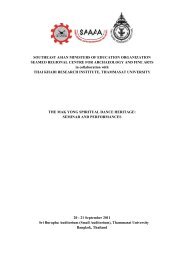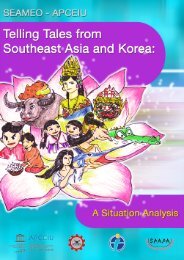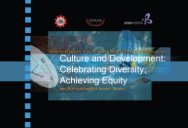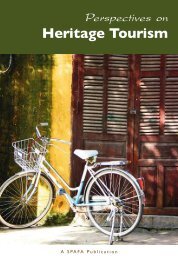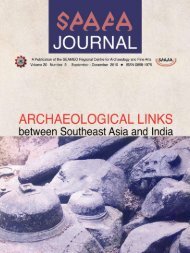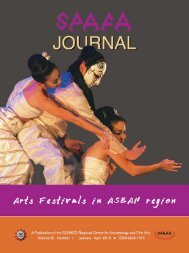Making Mangrove - Seameo-SPAFA
Making Mangrove - Seameo-SPAFA
Making Mangrove - Seameo-SPAFA
You also want an ePaper? Increase the reach of your titles
YUMPU automatically turns print PDFs into web optimized ePapers that Google loves.
Coastal Community in the Kingdomof Cambodia (A Case Study on <strong>Mangrove</strong> Management)Ouk Vibol• Management of the community’s incomes andexpenses• Community committee arrangement• Community committee election• Community meeting arrangement• Termination of the community• By-law revision procedure.Opportunities and ChallengesThe development of coastal communities is a highlychallenging project. However, a successful resourcemanagement-oriented coastal community requires manyconditions. These include:• A sustainable policy and legal framework• Good governance and decentralization• Conflict resolution mechanisms• Attention to gender and equity issues• Information-flow management (cooperation,networking, and knowledge sharing)• Enforcement• Monitoring and reflective learning analysis• Sustainable livelihood.• To enhance the natural environment.As expressed during the presentation, the case studyhas confirmed that there are both challenges and benefitsof coastal community organization. The challengesrelating to this resource management initiativeinclude its political aspect, the problem of transparency,the lack of communication and involvement of therelevant institutions, poor knowledge and poverty,and the lack of funding. However, the project has alsoproved that the benefits to be gained should outweighthe problems it has encountered:• Most local people understand the significance ofthe mangrove forest.• The coastal environment has improved.• The general incomes of the people in the communityhave been improved.• Illegal fishing activities have been reduced.• <strong>Mangrove</strong> logging and encroachment havestopped.• 70 hectares of mangrove forest have beenreplanted.Participatory Management of <strong>Mangrove</strong>Resources in Peam Krasaop Wildlife Sanctuary:A Case StudyComprising three districts, six communes, and 12villages, the Peam Krasaop area has a population of about10,000 people. It was declared by a royal decree asWildlife Sanctuary on 1 November 1993. Its mangroveswamp, which covers an area of 10,000 hectares, has34 species of birds and a rich biodiversity of fish, crabs,snails, turtles, dugongs, and dolphins. The aims oforganizing this coastal community are as follows:• To solve conflicts in the area• To find a way of raising the incomes of thepeople• To strengthen local awareness of importance ofcoastal resource management88 <strong>Making</strong> <strong>Mangrove</strong> Eco-Museums<strong>Making</strong> <strong>Mangrove</strong> Eco-Museums 89



